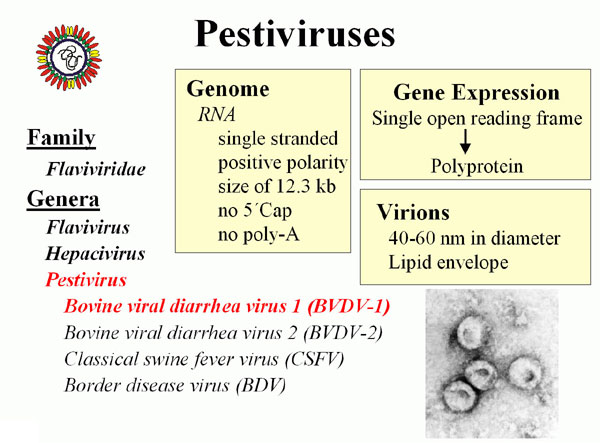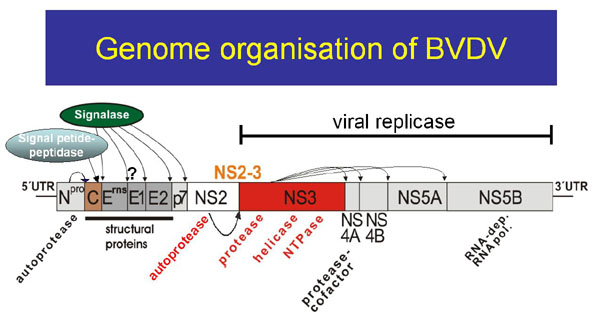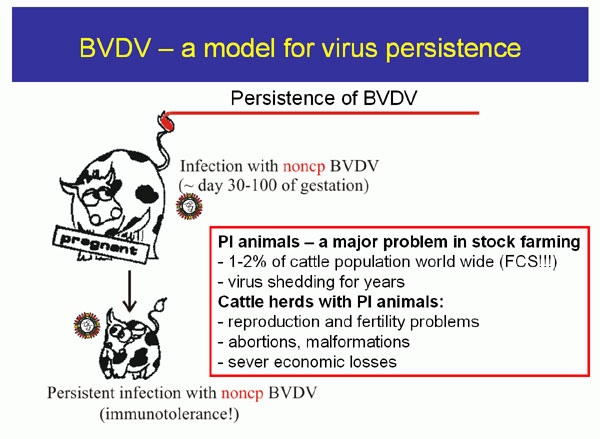Field of Investigations
Replication of Flaviviruses
Bovine viral diarrhea virus (BVDV-1, BVDV-2), Classical Swine Fever virus (CSFV), and border disease virus (BDV) of sheep form the genus Pestivirus in the family Flaviviridae. These viruses are economically highly important pathogens of live stock industries. This family also comprises the genus Flavivirus with members like tick borne encephalitis virus, yellow fever virus and dengue virus and the genus Hepacivirus represented by human hepatitis C virus (HCV). Currently members of all three genera are under investigation in scientific projects in the institute.


Pestiviruses are small (40-60 nm) enveloped viruses, with a single stranded RNA genome of positive polarity. Protein expression occurs via translation of a single large polyprotein which is co- and posttranslationally processed by cellular and virus-encoded proteases into the functional virus proteins. Bovine viral diarrhea virus (BVDV) serves as model virus.

Investigations concerning processing of the viral polyprotein and the enzymes involved are one of the main topics of our group. Processing of nonstructural protein 2-3 (NS2-3) is of special interest, since the extent of NS2-3 cleavage correlates with pestiviral cytopathogenicity. Accordingly, pestivirus strains which show efficient NS2-3 cleavage are cytopathogenic (cp) while the ones which show only inefficient NS2-3 cleavage are noncytopathogenic (noncp). Recent investigations have demonstrated a protease activity in pestiviral NS2; the regulation of this protease and its influence on pestiviral replication and cytopathogenicity are central points of our current work. Another goal of our investigations is the identification of viral factors involved in pestiviral cytopathogenicity.
Recently our group identified a cellular chaperone of the family of J-domain proteins which stably interacts with pestiviral NS2 and stimulates NS2-3 cleavage. Accordingly we termed this protein „J-domain protein interacting with viral protein“ (Jiv). Cells overexpressing Jiv show efficient NS2-3 cleavage and development of a cytopathogenic effect even upon infection with noncp pestivirus strains. We could demonstrate that Jiv (DNAJ-C14) represents an essential cofactor of the pestiviral NS2 protease. Limiting amounts of Jiv in the natural host cell is a crucial prerequisite for the noncp biotype of the virus and thereby its ability to establish a persistent infection. Tissue specific regulation of Jiv expression and its effect on pestiviral replication are major issues of our current work.
Major topics are the also the roles of different other NS proteins in pestiviral replication.
Human hepatitis C virus (HCV)
On the level of genome organization HCV is more closely related to pestiviruses as to the members of the genus Flavivirus. World wide about 130 million people suffer from chronic HCV infection. These infections are a major cause for liver cirrhosis and hepatucellular carcinoma. Present concepts of therapy resolve viral persistence only in a subpopulation of patients. Thus, further investigations aiming at the identification of viral targets as well as antivirals are urgently needed. Therefore, we investigate both HCV proteases in the NS2-3 region with respect to their function and regulation on molecular level with a special emphasis on the comparison to their pestiviral counterparts.

- Research
